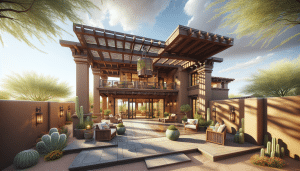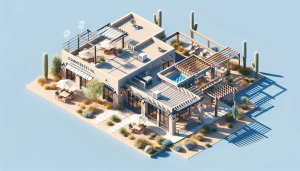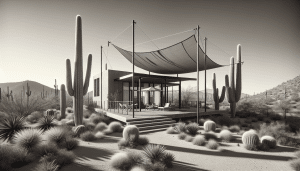Hot afternoon. Backyard grill firing up. You want shade—but not just a sheet flapping in the wind. You want something that looks good, lasts through monsoon season, and makes your patio feel like an extension of the house. That’s where shade sail accessories come in: small pieces that make a big difference. You know what? A couple of clever add-ons can turn a basic sail into a comfortable, stylish outdoor room. Let me explain.
Contents
- 1 So, what are shade sail accessories—really?
- 2 Hardware that holds everything together (and why it matters)
- 3 Poles, posts, and anchors — the backbone
- 4 Comfort and style extras (because who wants bland shade?)
- 5 Maintenance, seasonal tweaks, and a little local wisdom
- 6 A quick guide to choosing what to buy (because choices can be overwhelming)
- 7 Putting it all together—local tips for Maricopa County
- 8 Ready to upgrade your outdoor living?
So, what are shade sail accessories—really?
Accessories are the nuts and bolts, the little luxuries, and the safety bits that let a shade sail do its job (protect from sun), look great, and survive the elements. Some are downright mechanical—turnbuckles, pad eyes, stainless shackles—while others are decorative—valances, lights, side curtains. They sound simple, but their choices affect tension, wind resistance, drainage, and yes, the whole vibe of your yard.
Hardware that holds everything together (and why it matters)
Here’s the thing: a sail is only as good as the hardware that secures it. Cheap fittings corrode, twist, or fail when Maricopa County winds pick up. Stainless steel is your friend. Galvanized may work, but stainless lasts longer with less fuss.
- Turnbuckles and tensioners: These let you tighten and fine-tune the sail. You can get ratchet-style tensioners for heavy-duty jobs or simple screw turnbuckles for smaller sails.
- Pad eyes & brackets: Mounted to houses, Posts, or concrete—choose heavy-gauge, marine-grade fittings so they don’t bend or pull out under load.
- Shackles and carabiners: Look for stainless D-shackles or pear-shaped variants. Quick-release carabiners are handy for seasonal removal.
- Edge reinforcements and corner rings: These distribute force. If you skimp here, you’ll get rips or puckering where you least expect it.
Honestly, it’s like building a boat. The sail is only part of the equation; the rigging keeps everything afloat.
Poles, posts, and anchors — the backbone
Some people think poles are poles. Not true. Material, diameter, and footing depth matter more than you’d guess. Steel poles are robust and clean-looking; powder-coated finishes resist rust and reflect glare. Aluminum is lighter and resists corrosion, but it can flex in high winds. Wood? It gives a warm, rustic look, but needs sealing and maintenance—so there’s a mild contradiction: wood looks great but asks for more upkeep.
Anchoring is where your project either stands tall or ends up leaning. Concrete footings with sleeves are the standard in Maricopa County. There are also ground anchors and helical piles for tricky soils. Choose according to your soil, wind loads, and whether you’re doing a permanent Installation or something seasonal.
Comfort and style extras (because who wants bland shade?)
Now we get to the fun bits. Accessories that boost comfort and create atmosphere are surprisingly affordable and instantly transformative.
- Side curtains and privacy screens: Great for early evenings when you want shade plus shelter from wind or neighbors.
- Integrated lighting: Solar string lights or LED strips mounted on the sail seams—instant ambiance, low running cost.
- Rain gutters and drainage: Yes, some sails can channel water. Small, flexible gutters or grommet drains stop puddles and sagging.
- Wind vents and reliefs: Tiny vents reduce uplift during gusts. They’re small, but they’re lifesavers when a monsoon rolls through.
- Decorative valances and color trims: They hide hardware and give a finished look, like a frame around a painting.
These extras are the difference between “functional cover” and “outdoor living room.” And they’re not just pretty—lighting and screens extend usability into the evening when Arizona nights cool down and the desert smells different. You can practically hear the cicadas quieting.
Maintenance, seasonal tweaks, and a little local wisdom
Shade Sails aren’t completely set-and-forget. Dust from desert winds, UV degradation, and the occasional storm mean you’ll want a plan. Here’s a practical checklist—short and useful:
- Regular inspections: Check seams, stitching, and hardware every 3–6 months. Replace any corroded shackles or frayed corners before they fail.
- Cleaning: Mild soap, soft brush, and rinse. Avoid bleach; it eats Fabric and Colors. For stubborn stains, there are specialty fabric cleaners and UV protectant sprays (Gorilla Glue’s fabric cleaners get decent reviews in DIY forums).
- Seasonal removal: Many homeowners remove sails during heavy monsoon season or when they store them for winter. Quick-release hardware makes this less of a chore.
- Storage: Use a breathable bag, not a plastic bin. Moisture trapped in a sealed bag creates mildew, even in dry climates.
Monsoon season demands respect. You might love the drama of sudden storms, but your sail doesn’t. Wind vents, quick-release anchors, and knowing when to take it down will save you money and headaches.
A quick guide to choosing what to buy (because choices can be overwhelming)
Let’s simplify. Ask yourself three questions:
- How permanent is this? If permanent, invest in stainless hardware and concrete footings. If seasonal, focus on quick-release fittings and lighter poles.
- What’s your priority—shade, style, or storm resistance? Shade-only means breathable, affordable fabric. Style-focused? Pick colors, valances, and integrated lighting. Storm resistance? Reinforced corners, vents, and heavy-duty tensioners.
- How much maintenance will you do? If you hate maintenance, choose high-grade Materials and simple, removable designs.
Mixing these answers gives you a clear shopping list. And no, there’s no single “best” setup—there are right fits for your yard and your patience level.
Putting it all together—local tips for Maricopa County
Living here changes the rules a bit. Sun intensity is high, so UV rating matters; look for fabrics rated for UV protection and high UV-stability fabric like HDPE with UV stabilization. Dust storms mean tighter seams and better tension, while summer heat encourages lighter colors to reflect sun. If you have an HOA, check local rules before drilling into a shared wall or installing tall poles—some communities have rules about sightlines and materials.
Neighbors in Phoenix, Mesa, Chandler—they often go for colors that complement desert palettes: terra-cotta, sage, and sand. It’s subtle, but the right color makes a sail feel like it belongs. And yes, a little color psychology goes a long way at your next barbecue.
Ready to upgrade your outdoor living?
Accessories turn a simple sail into a practical, beautiful structure that stands up to heat and wind—and that you’ll actually enjoy using. If you’d like help picking hardware, setting poles, or planning a full install in Maricopa County, Arizona Shade Sails can help. Call us at 480-418-8438 or Request a Free Quote to start the conversation. Let’s get your backyard working for you—shade, style, and comfort included.




